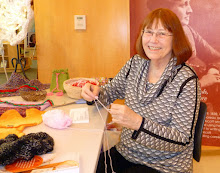On International Tatting Day (April 1st) I will be leading a workshop, "Bling Your Shuttle," at the
North Carolina Regional Lacers Spring Lace Day in Chapel Hill, NC. Participants will decorate tatting shuttles using a
selection of origami papers and decoupage medium. To further inspire the tatters and give them ideas, I will also have a display of shuttles that I have decoupaged in various ways. The class should be a lot of fun for everyone.
I show here some of the examples that I plan to bring to the class along with comments on the process for each one.
This is one of my earliest efforts. The paper is origami paper on a Susan Bates plastic shuttle. Origami paper comes in a vast selection of patterns and lends itself well to decoupaging. The decoupage medium is Mod Podge Gloss.
Here's another shuttle decoupaged with origami paper, this time on a Handy Hands Moonlit shuttle. The addition of the hook means that care is needed to make sure the paper is secure on that end of the shuttle so thread doesn't catch on it when using the hook.
I've included this example to show that selection of paper is as important as careful decoupaging. This design came from the same pack of origami paper as the one above. But the design is so pale that is fades into the background. The shuttle is a Handy Hands Sunlit and the decoupaging was done with Mod Podge Gloss and finished with a couple of coats of Martha Stewart Crafts High Gloss Finish.
This is a Lacis Sew Mate shuttle decoupaged with paper a little heavier than origami paper. It's from a book of papers that simulate the effect of marblized paper. One thing to watch out for when using some printed papers is that part of the printing can rub off during the decoupaging process. You can see on the bottom left edge that this has happened in a small spot. Repeated coats of the decoupage medium can prevent this from spreading. Again, Mod Podge Gloss was the medium used.
Here's another Handy Hands Sunlit shuttle, but this time only Mod Podge Extreme Glitter was used to decorate it. So you can play around with various coatings and get some interesting effects without the addition of paper.
Here's another Handy Hands Sunlit shuttle coated only with Mod Podge Extreme Glitter and and the addition of a little piece of tatting in size 80 thread. Not only is this a great way to show off your tatting, but the texture of the tatting provides a good grip on the shuttle.
Yet another Handy Hands Sunlit shuttle, but this time, instead of origami paper, I used a decorative bag made of almost tissue thickness paper. The bag contained a souvenir from my daughter's trip to Italy so not only is the design a fun one to have on a shuttle, but it's also a reminder of my daughter's thoughtful gift. Using papers collected on trips (paper bags, paper napkins) is a nice way to create a useful remembrance.

I usually only decorate the top side of my shuttles, but this Susan Bates shuttle is the exception. It is an example of a decorating failure and a rescue from that failure. I originally painted this shuttle with Martha Stewart Crafts Gold Liquid Gilding. I've had great success using this on a damaged wooden picture frame, but this was the first, and only, time I used it on plastic. It did not do well on this surface and the gilding rubbed off in an unsightly way. You can see some of the remains of the gilding on the underside of the tip in the bottom photo. I decided to cover the ugly with origami paper on both sides. I used Mod Podge Gloss to attach the paper and then several coats of Martha Stewart Crafts High Gloss Finish to give it even more shine.


Here I'm playing with little plastic stickers, the kind found in any scrapbooking department in craft stores. The Handy Hands Moonlit shuttle was first coated with Mod Podge Gloss and the sticker applied to the wet surface. After drying, several coats of Martha Stewart Crafts High Gloss Finish were added to give the surface a shine and to insure that the sticker would stay stuck.
Here's another attempt that taught me something. This Clover shuttle is decoupaged with silver metallic origami paper. I find that this paper can be more fragile than the non-metallic papers. During the decoupaging operation, some of the paper almost rubbed off as can be seen near the tip of the shuttle. I won't be using this type of paper again. I added another from my sticker stash and gave the shuttle many coats of Martha Stewart Crafts High Gloss Finish to protect the paper from further rubbing off and to make sure the sticker would not peel off.




















